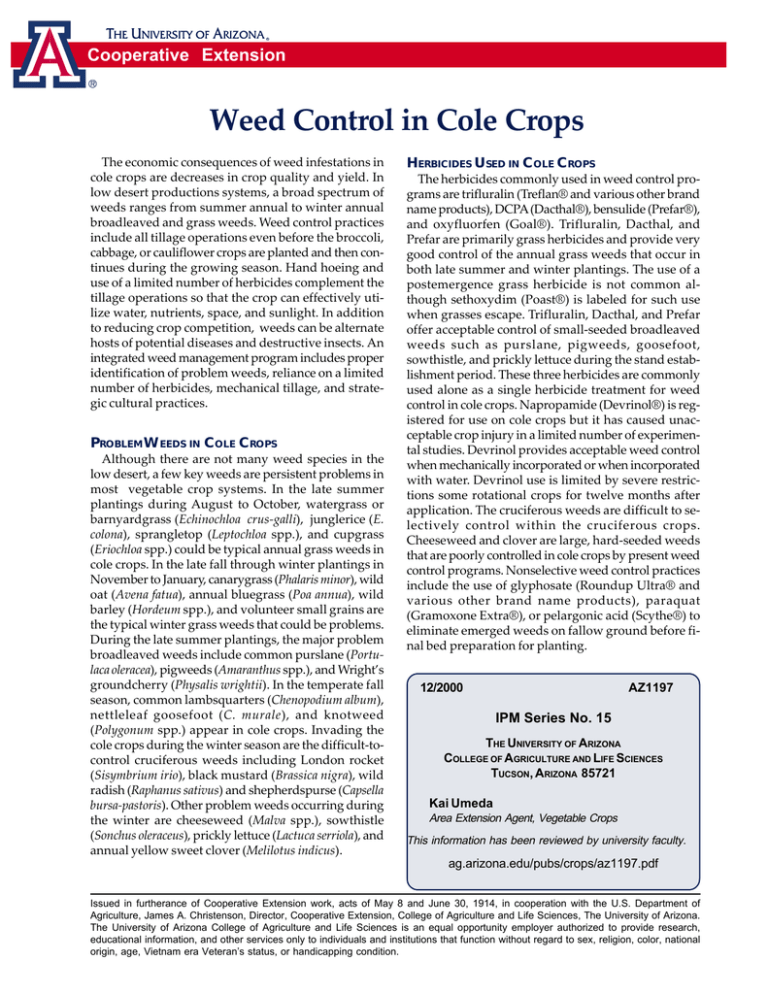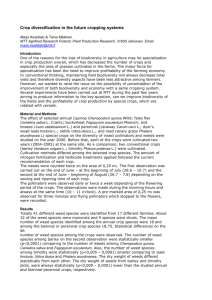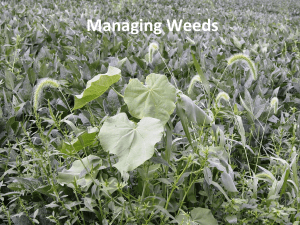Weed Control in Cole Crops Cooperative Extension
advertisement

Cooperative Extension Weed Control in Cole Crops The economic consequences of weed infestations in cole crops are decreases in crop quality and yield. In low desert productions systems, a broad spectrum of weeds ranges from summer annual to winter annual broadleaved and grass weeds. Weed control practices include all tillage operations even before the broccoli, cabbage, or cauliflower crops are planted and then continues during the growing season. Hand hoeing and use of a limited number of herbicides complement the tillage operations so that the crop can effectively utilize water, nutrients, space, and sunlight. In addition to reducing crop competition, weeds can be alternate hosts of potential diseases and destructive insects. An integrated weed management program includes proper identification of problem weeds, reliance on a limited number of herbicides, mechanical tillage, and strategic cultural practices. PROBLEM WEEDS IN COLE CROPS Although there are not many weed species in the low desert, a few key weeds are persistent problems in most vegetable crop systems. In the late summer plantings during August to October, watergrass or barnyardgrass (Echinochloa crus-galli), junglerice (E. colona), sprangletop (Leptochloa spp.), and cupgrass (Eriochloa spp.) could be typical annual grass weeds in cole crops. In the late fall through winter plantings in November to January, canarygrass (Phalaris minor), wild oat (Avena fatua), annual bluegrass (Poa annua), wild barley (Hordeum spp.), and volunteer small grains are the typical winter grass weeds that could be problems. During the late summer plantings, the major problem broadleaved weeds include common purslane (Portulaca oleracea), pigweeds (Amaranthus spp.), and Wright’s groundcherry (Physalis wrightii). In the temperate fall season, common lambsquarters (Chenopodium album), nettleleaf goosefoot (C. murale), and knotweed (Polygonum spp.) appear in cole crops. Invading the cole crops during the winter season are the difficult-tocontrol cruciferous weeds including London rocket (Sisymbrium irio), black mustard (Brassica nigra), wild radish (Raphanus sativus) and shepherdspurse (Capsella bursa-pastoris). Other problem weeds occurring during the winter are cheeseweed (Malva spp.), sowthistle (Sonchus oleraceus), prickly lettuce (Lactuca serriola), and annual yellow sweet clover (Melilotus indicus). HERBICIDES USED IN COLE CROPS The herbicides commonly used in weed control programs are trifluralin (Treflan® and various other brand name products), DCPA (Dacthal®), bensulide (Prefar®), and oxyfluorfen (Goal®). Trifluralin, Dacthal, and Prefar are primarily grass herbicides and provide very good control of the annual grass weeds that occur in both late summer and winter plantings. The use of a postemergence grass herbicide is not common although sethoxydim (Poast®) is labeled for such use when grasses escape. Trifluralin, Dacthal, and Prefar offer acceptable control of small-seeded broadleaved weeds such as purslane, pigweeds, goosefoot, sowthistle, and prickly lettuce during the stand establishment period. These three herbicides are commonly used alone as a single herbicide treatment for weed control in cole crops. Napropamide (Devrinol®) is registered for use on cole crops but it has caused unacceptable crop injury in a limited number of experimental studies. Devrinol provides acceptable weed control when mechanically incorporated or when incorporated with water. Devrinol use is limited by severe restrictions some rotational crops for twelve months after application. The cruciferous weeds are difficult to selectively control within the cruciferous crops. Cheeseweed and clover are large, hard-seeded weeds that are poorly controlled in cole crops by present weed control programs. Nonselective weed control practices include the use of glyphosate (Roundup Ultra® and various other brand name products), paraquat (Gramoxone Extra®), or pelargonic acid (Scythe®) to eliminate emerged weeds on fallow ground before final bed preparation for planting. 12/2000 AZ1197 IPM Series No. 15 THE UNIVERSITY OF ARIZONA COLLEGE OF AGRICULTURE AND LIFE SCIENCES TUCSON, ARIZONA 85721 Kai Umeda Area Extension Agent, Vegetable Crops This information has been reviewed by university faculty. ag.arizona.edu/pubs/crops/az1197.pdf Issued in furtherance of Cooperative Extension work, acts of May 8 and June 30, 1914, in cooperation with the U.S. Department of Agriculture, James A. Christenson, Director, Cooperative Extension, College of Agriculture and Life Sciences, The University of Arizona. The University of Arizona College of Agriculture and Life Sciences is an equal opportunity employer authorized to provide research, educational information, and other services only to individuals and institutions that function without regard to sex, religion, color, national origin, age, Vietnam era Veteran’s status, or handicapping condition. Trifluralin (0.5 to 0.75 lb. AI/A) The actual rates used on cole crops is primarily determined by the soil texture and organic matter content. Trifluralin is typically applied broadcast on the soil surface and then mechanically incorporated prior to listing beds. Broccoli, cabbage, and cauliflower can be direct-seeded or transplanted into trifluralin-treated soil. Direct-seeded crops may be adversely affected by trifluralin when soil temperatures are extremely hot in the late summer or in the winter with cold soil temperatures. Emerging seedlings are stressed when growing within the trifluralin-treated soil and the added stress of hot or cold temperatures reduces the seedling vigor. Extended hot or cold temperatures can significantly reduce the crop stand. Dacthal (6 to 14 lb. AI/A) Dacthal is typically applied preemergence, broadcast on the soil surface and then activated by irrigation. Sprinkler irrigation is the most effective method for uniformly incorporating Dacthal into the soil surface where it will control germinating weeds. Furrow and drip irrigation usually do not apply water or wet the bed surface uniformly and may not effectively activate preemergence herbicides. Dacthal provides relatively good control of most of the grasses and broadleaved weeds except the cruciferous weeds. Cheeseweed and clover often escape Dacthal treatments. Prefar (up to 6.0 lb. AI/A) Prefar is typically applied preemergence broadcast or banded to the soil surface and then activated by irrigation. Sprinkler irrigation immediately after application is the most effective method for uniformly incorporating Prefar to a depth of one-half inch where it controls weeds that germinate with the crop. Furrow and drip irrigation usually do not uniformly apply water to equally wet the bed surface to effectively activate the preemergence applied herbicide. Prefar may be applied by chemigation through sprinklers. Prefar offers good control of most of the grass weeds, purslane, and some pigweeds. Goal (0.25 to 0.5 lb. AI/A) Goal is labeled for use only as a soil applied treatment before transplanting broccoli, cabbage, and cauliflower. Goal should be applied broadcast or banded on the soil surface of the prepared beds prior to transplanting. To achieve the most effective control of emerging weed seedlings, transplanting should be completed with minimum soil surface disturbance to maintain the Goal herbicide barrier. Leaves of transplants that contact treated soil may display slight leaf cupping injury symptoms. Goal will cause significant crop in2 The University of Arizona Cooperative Extension jury if applied on the crop foliage by postemergence applications. Goal controls only broadleaved weeds and does not control grass weeds. Poast (0.09 to 0.28 lb. AI/A) Poast is used as a broadcast postemergence or spot treatment when grass weeds become a problem in cole crops. Small actively growing grasses are most susceptible to Poast applications and require lower rates of application. Larger grasses approaching tillering or heading stages of growth require higher rates of Poast and may not be completely controlled. Poast applications are most effective when a crop oil concentrate is added to the final spray solution. Poast is effective against most annual and perennial grass weeds. Poast does not control annual bluegrass and is not very effective against sprangletop. MECHANICAL WEED CONTROL IN COLE CROPS Land preparation beginning with deep moldboard plowing or ripping can bury weed residues and weed seeds from previous crops thus adding to the weed seed bank in the soil. Dormant weed seed may also be returned to near the surface and breaking dormancy so that it could germinate and weed seedlings could emerge. Preirrigation by flooding a level basin field or by sprinkler irrigation in a newly listed field could force germination and emergence of anticipated problem weeds. The emerged weeds can be removed applying a nonselective herbicide or mechanically removed by using a rotary hoe, power tiller, disk, or harrow. Disturbing the soil mechanically will more than likely expose more weed seeds and induce subsequent seedling emergence. After crop stand establishment, hand hoeing may remove weeds at the same time that the crop stand is being thinned. Since there are no selective postemergence herbicides for broadleaved weeds, several cultivations using a variety of implements including sweeps, shanks, disks, knives, and rolling cultivators mounted on tool bars are typically used to remove or bury emerging weeds between the rows of cole crops. Cabbage and broccoli are typically planted with two seedlines on a 38 to 42-inch shaped bed and the tops of the beds are cultivated as well as the shoulders and the bottom of the furrows. Precision cultivation allows steel implements to approach the crop within a few inches. Precisely shaped beds and precision placement of crop seeds allow cultivation that minimally disturbs the soil thus minimizing additional weed seed germination from below the herbicide treated soil. Preemergence herbicides are more effective when applied on clod-free, precisely shaped beds. Hand hoeing is still necessary when weeds continue to emerge within the seed row and compete with the crops. CULTURAL AND BIOLOGICAL WEED CONTROLS COLE CROPS IN The date of planting of cole crops, environmental conditions, and cultural practices determine the spectrum of weeds that occur in fall or spring harvested crops. Growers in different geographic locations will alter the date of planting due to varying micro-climatic conditions and this affects the species of weeds that emerge. Rainfall in the winter has a tendency to cause the emergence of a new flush of weeds if it occurs after cultivations and before a scheduled irrigation. The movement of weed seed in mud, dirt, and plant residues stuck on tractors, tillage implements, and harvest equipment can be reduced by cleaning equipment between farm fields. Irrigation water from sumps, reservoirs, and canals can transport weed seed from different locations to newly planted cole crop fields. The use of manure can spread weed seed to fields. Well composted manures are less likely to spread viable, undigested weed seeds that were fed to animals. Encourage the cole crop to grow as vigorously as possible to effectively outcompete any emerging weeds. At planting, precisely plant seeds to enable uniform stand emergence and establishment. Irrigate and fertilize the crop in a timely manner to optimize crop utilization of the applied nutrients. Apply proper amounts of starter fertilizer and then sidedress at appropriate intervals to encourage effective competition. Broccoli and cauliflower can effectively establish a canopy and shade out weed competition between the rows. Crop rotations and knowledge of field conditions are helpful for minimizing weed problems in cole crops. Rotating and planting high value cole crops on lands of unknown weed history could lead to disaster with a plethora of atypical weeds emerging. Generally, vegetable crops following another vegetable crop or cotton that had optimal weed control will continue to have minimal weed problems. Vegetable crops planted after alfalfa may become weedy due to the nature of alfalfa being grown for multiple years and decreasing weed control practices as the crop stand declines and weeds proliferate and go to seed. Watermelon fields similarly tend to get excessively weedy during the end of a long growing season and contribute to the seedbank in the soil. Small grains planted during the previous winter often pose competitive problems for cole crops that the preemergence grass herbicides will not adequately control and then Poast herbicide may be necessary to eliminate the volunteer grains. Volunteer melons from a previous cantaloupe crop commonly emerge in cole crop plantings in the early fall where cultivation and hand hoeing are the only means of removal until a killing frost occurs in the late fall. Cole crops should be planted on ground that is known to be free of excessive weed problems. If herbicides were used in a previous crop, read the label to ensure that there are no restrictions or limitations for growing cole crops. Biological control agents are difficult to establish or augment in most short season vegetable crops. Microbial pathogens or herbivorous insects often cannot get established early enough to reduce weeds that are actively competing with the crops soon after emergence. Some seed-feeding insects or pathogens may occur in the soil and may reduce some seeds of certain weed species. ACKNOWLEDGMENTS The review and editing by W.M. McCloskey, Extension Weed Specialist, and P. Clay, Extension Agent, were greatly appreciated. SUGGESTED REFERENCES Bowman, G., editor. 1997. Steel in the Field, A farmer’s guide to weed management tools. Sustainable Agriculture Network, National Agricultural Library, Beltsville, MD. California Weed Conference. 1989. Principles of Weed Control in California, 2nd Edition. Thompson Publications, Fresno, CA Kempen, H.M. 1993. Growers Weed Management Guide, 3rd Edition. Thompson Publications, Fresno, CA. Maynard, D.N. and Hochmuth, G. J. 1997. Knott’s Handbook for Vegetable Growers, 4th Edition. John Wiley and Sons, New York, NY. Meister, R.T., editor. 2000. Weed Control Manual 2000. Meister Publishing Company, Wiloughby, OH. Parker, K.F. 1982. An Illustrated Guide to Arizona Weeds. University of Arizona Press. NOTE: This information summarizes suggestions for herbicides used to supplement other weed control practices in Arizona cole crops.The suggestions are in conformance with currently available labels for each product. Because these labels are subject to frequent change, always consult the product label before using any herbicide. The user must assume responsibility for proper application of herbicides and for residues on crops as well as any damage or injury caused by herbicides referred to in this bulletin, whether to crop, person, or property. Any products, services, or organizations that are mentioned, shown, or indirectly implied in this publication do not imply endorsement by The University of Arizona. The University of Arizona Cooperative Extension 3





